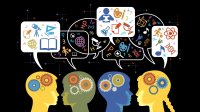Helping Struggling Students Build a Growth Mindset
Veteran researchers present five strategies—like maintaining success files and allowing choice—to help struggling students develop a positive attitude needed for success.
Your content has been saved!
Go to My Saved Content.As researchers and teacher educators, we have found that a gift many effective educators give struggling students is a practical and optimistic mindset coupled with strategies that help them learn successfully. Over the last two decades, we have supported teachers in teaching students about their brilliant brains and in showing students strategies to support positive outlooks about their learning capabilities.
Our research aligns well with Carol Dweck’s work on growth mindset, or acting on the belief that abilities can be developed through dedication and hard work. In a previous post, we discussed the importance of growth mindset for teachers.
Now we turn to the benefits of helping students who find school difficult maintain a positive mindset as they persist in the sometimes hard work required for learning. When failures mount, it’s easy to give up. A positive mindset focuses on the gains that are possible when students persevere through learning challenges. Here are five strategies to help struggling students develop a growth mindset.
Encouraging Optimism About Learning
This outlook helps struggling students become more motivated, alert, and ready to learn, so that neurotransmitters that enable learning can be released. Many students who have learning challenges become pessimistic about school and lose hope that they can make academic progress. These teaching strategies help reinforce how useful it can be to develop a state of practical optimism:
- Model practical optimism and point out examples of this approach in action; for example, say, “We knew this would be a tough project, but we stuck with it and worked hard. Just look at what we’ve accomplished!”
- Share examples of how you have overcome learning obstacles. It’s helpful for struggling students to realize that everyone occasionally faces learning challenges.
- Share stories that illustrate the benefits of practical optimism.
- Maintain a positive learning atmosphere by posing questions such as “What was the best thing that happened today?”
In previous posts, we’ve discussed cultivating practical optimism in the classroom and in schools generally.
Teaching Students to Learn More Effectively
When struggling students learn how to “drive their brains” through the use of cognitive strategies, they’re more likely to be able to learn and think at higher levels. Teachers often tell us they need strategies for helping students learn how to increase their attention. Our post “Strategies for Getting and Keeping the Brain’s Attention” offers tried-and-true strategies to support teachers with this common classroom issue. And Edutopia’s “Resources on Learning and the Brain” features other easy-to-use strategies for assisting students to learn more effectively.
Maintaining Success Files
A success file is a continually updated collection that provides ready evidence to help students internalize and remember their learning successes. Here is one way to use this strategy:
- Give every student a folder to use as a success file.
- Ask students to write the word success on their file and/or draw a picture that represents success for them.
- Every day, when possible, ask students to add to their folders examples of successful learning, such as tasks completed, examples of learning gains, and assignments that support their personal definitions of success.
- At the start of each school day or class, remind students to look through their success file. The more students can reconnect to their previous achievements, the more positive their mindsets can become and the more successful they’ll be in the long run.
Using Growth Assessments
Growth assessments is the term we use for formative assessments that help guide student learning and monitor progress. Students with learning challenges benefit when teachers check in often and provide additional instruction and feedback when necessary. Growth assessments help students identify their strengths and areas of weakness that need further practice and reinforcement, and may include class discussions, interviews with individual students, consultations on drafts of work, and observations of how students are applying what they’ve learned. Students may use self-assessments such as journal entries and personal checklists so they can be prompted to monitor their progress. Keeping track of their growth, including learning challenges they have overcome, helps to foster a growth mindset.
Letting Students Choose
When students can choose topics of personal interest to study or make the subject of a learning project, they are more likely to maintain interest and motivation. Giving students choices also underscores that they are in charge of their learning.
One of the greatest thrills for teachers is to see the light bulb switch on for struggling students as they learn something new and internalize the belief that through effort and the use of sound strategies they can keep growing their skills and knowledge.
